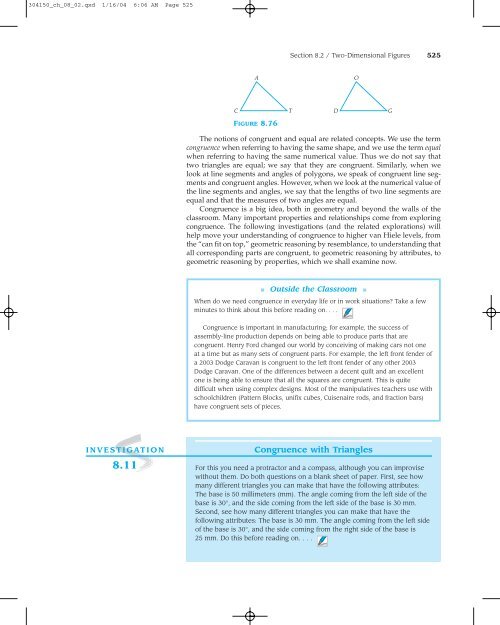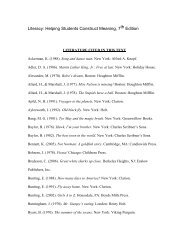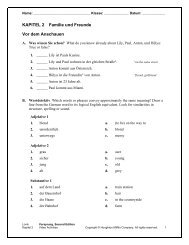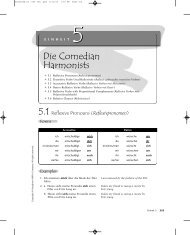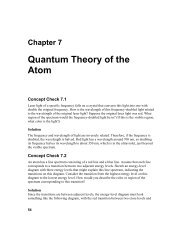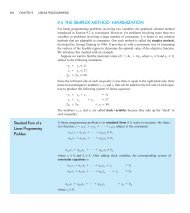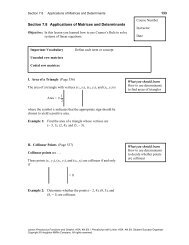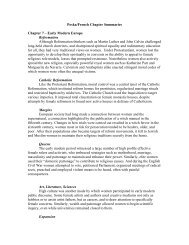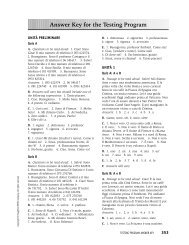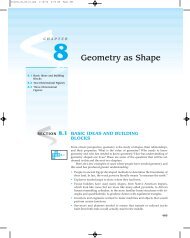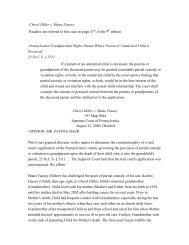SECTION 8.2 TWO-DIMENSIONAL FIGURES - Cengage Learning
SECTION 8.2 TWO-DIMENSIONAL FIGURES - Cengage Learning
SECTION 8.2 TWO-DIMENSIONAL FIGURES - Cengage Learning
You also want an ePaper? Increase the reach of your titles
YUMPU automatically turns print PDFs into web optimized ePapers that Google loves.
304150_ch_08_02.qxd 1/16/04 6:06 AM Page 525<br />
INVESTIGATION<br />
8.11<br />
C<br />
A<br />
FIGURE 8.76<br />
Section <strong>8.2</strong> / Two-Dimensional Figures 525<br />
T D<br />
The notions of congruent and equal are related concepts. We use the term<br />
congruence when referring to having the same shape, and we use the term equal<br />
when referring to having the same numerical value. Thus we do not say that<br />
two triangles are equal; we say that they are congruent. Similarly, when we<br />
look at line segments and angles of polygons, we speak of congruent line segments<br />
and congruent angles. However, when we look at the numerical value of<br />
the line segments and angles, we say that the lengths of two line segments are<br />
equal and that the measures of two angles are equal.<br />
Congruence is a big idea, both in geometry and beyond the walls of the<br />
classroom. Many important properties and relationships come from exploring<br />
congruence. The following investigations (and the related explorations) will<br />
help move your understanding of congruence to higher van Hiele levels, from<br />
the “can fit on top,” geometric reasoning by resemblance, to understanding that<br />
all corresponding parts are congruent, to geometric reasoning by attributes, to<br />
geometric reasoning by properties, which we shall examine now.<br />
■ Outside the Classroom ■<br />
When do we need congruence in everyday life or in work situations? Take a few<br />
minutes to think about this before reading on. . . .<br />
Congruence is important in manufacturing; for example, the success of<br />
assembly-line production depends on being able to produce parts that are<br />
congruent. Henry Ford changed our world by conceiving of making cars not one<br />
at a time but as many sets of congruent parts. For example, the left front fender of<br />
a 2003 Dodge Caravan is congruent to the left front fender of any other 2003<br />
Dodge Caravan. One of the differences between a decent quilt and an excellent<br />
one is being able to ensure that all the squares are congruent. This is quite<br />
difficult when using complex designs. Most of the manipulatives teachers use with<br />
schoolchildren (Pattern Blocks, unifix cubes, Cuisenaire rods, and fraction bars)<br />
have congruent sets of pieces.<br />
Congruence with Triangles<br />
For this you need a protractor and a compass, although you can improvise<br />
without them. Do both questions on a blank sheet of paper. First, see how<br />
many different triangles you can make that have the following attributes:<br />
The base is 50 millimeters (mm). The angle coming from the left side of the<br />
base is 30°, and the side coming from the left side of the base is 30 mm.<br />
Second, see how many different triangles you can make that have the<br />
following attributes: The base is 30 mm. The angle coming from the left side<br />
of the base is 30°, and the side coming from the right side of the base is<br />
25 mm. Do this before reading on. . . .<br />
O<br />
G


